The long time coming GeForce RTX Super graphics cards are here and without wasting any time, let's take a look at the specs and pricing to see what we're dealing with.
The new RTX 2060 Super is coming in at $400, a small price premium over existing non-Super models. For that 14% bump in price you receive a significant upgrade in terms of specs, though at first glance that may not appear to be the case. We're receiving a small 13% boost in CUDA cores, however we also see a massive 33% increase in ROPs and this extends the 192-bit wide memory bus of the original RTX 2060 to 256-bit wide for the Super version.
Because the same 14 Gbps GDDR6 memory is used, the bandwidth has increased by 33% to 448 GB/s, so then the RTX 2060 Super has the same memory subsystem as the RTX 2070 and 2070 Super, and this means it gets 8GB of VRAM. Essentially it's a slightly cut down version of the 2070 as both use TU106 silicon.
The new RTX 2060 Super is a slightly cut down version of the original RTX 2070 as both use TU106 silicon. Meanwhile, the RTX 2070 Super is a boosted version of the original for the same price.
The RTX 2070 Super comes in at the same $500 price point as the original, effectively replacing this part and you can expect vanilla 2070s to be phased out shortly. For the same money we're getting an 11% upgrade in CUDA cores and 28% more Texture Units while the ROP count remains the same.
We see a reasonable 9% increase in boost clocks for the core, but given most cards are factory overclocked this will have little impact on performance. Finally, the memory configuration remains the same, 8GB of GDDR6 memory with data rate of 14 GBps for a bandwidth of 448 GB/s. Unlike the standard 2070 which uses TU106 silicon, the Super version has been upgraded to TU104, the same silicon used by the RTX 2080.
The RTX 2060 Super looks to be a rather substantial upgrade over the base model, but you're paying a bit more. While the 2070 Super looks to be a similar upgrade over the 2070, but in this case you're getting that extra performance at no added cost. I guess it's the extra memory that Nvidia's stinging gamers for with the 2060 Super.
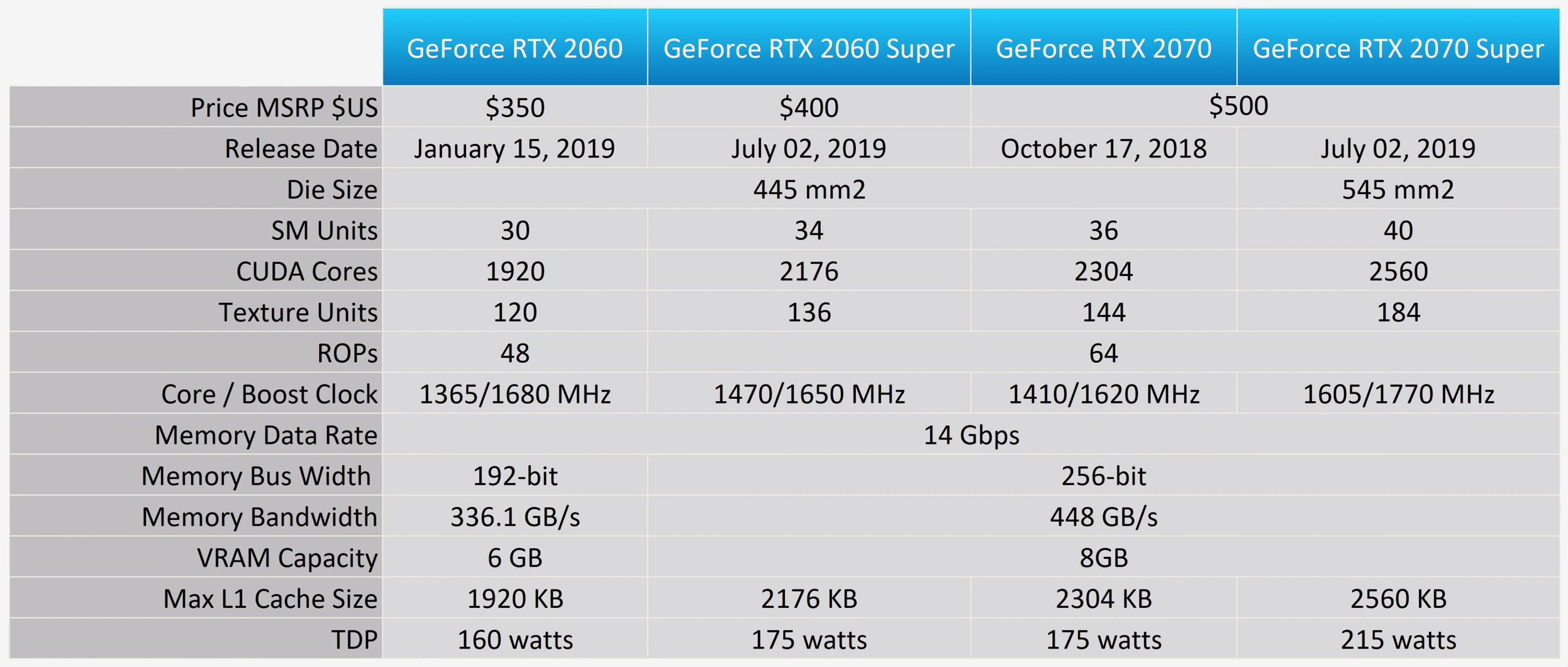
There will also be an RTX 2080 Super and that model is going to slot in at the same $700 price point (same as the original) and arrive later, in July 23. Nvidia has teased it'll have 15.5 Gbps GDDR6 memory and it will be faster than the Titan Xp. We don't expect it to reach 2080 Ti levels of performance but it should be a nice boost overall nonetheless, again, for the same price.
For testing the RTX 2070 Super and RTX 2060 Super we've used a Core i9-9900K clocked at 5 GHz with 32GB of DDR4-3400 memory. The latest drivers available at the time of testing have been used and all the data was gathered fresh for this review. We have 12 games to look at before the usual performance breakdowns and cost per frame data. Let's get into the results.
Benchmarks
First up we have Battlefield V and here we see the 2070 Super bridging the gap between the 2070 and 2080, not a massive performance boost but not bad either. The Radeon VII is still 18% faster in this title, but it does cost at least 36% more, I suspect the 2070 Super is going to cause more pain for AMD's current flagship GPU.
Meanwhile the RTX 2060 Super looks... adequate. It was 9% faster than the RTX 2060 in this title and while that had it nipping at the 2070's heals and ahead of Vega 56, that's not exactly an exciting result given it costs 14% more, but I guess there is some utility in having that extra VRAM.
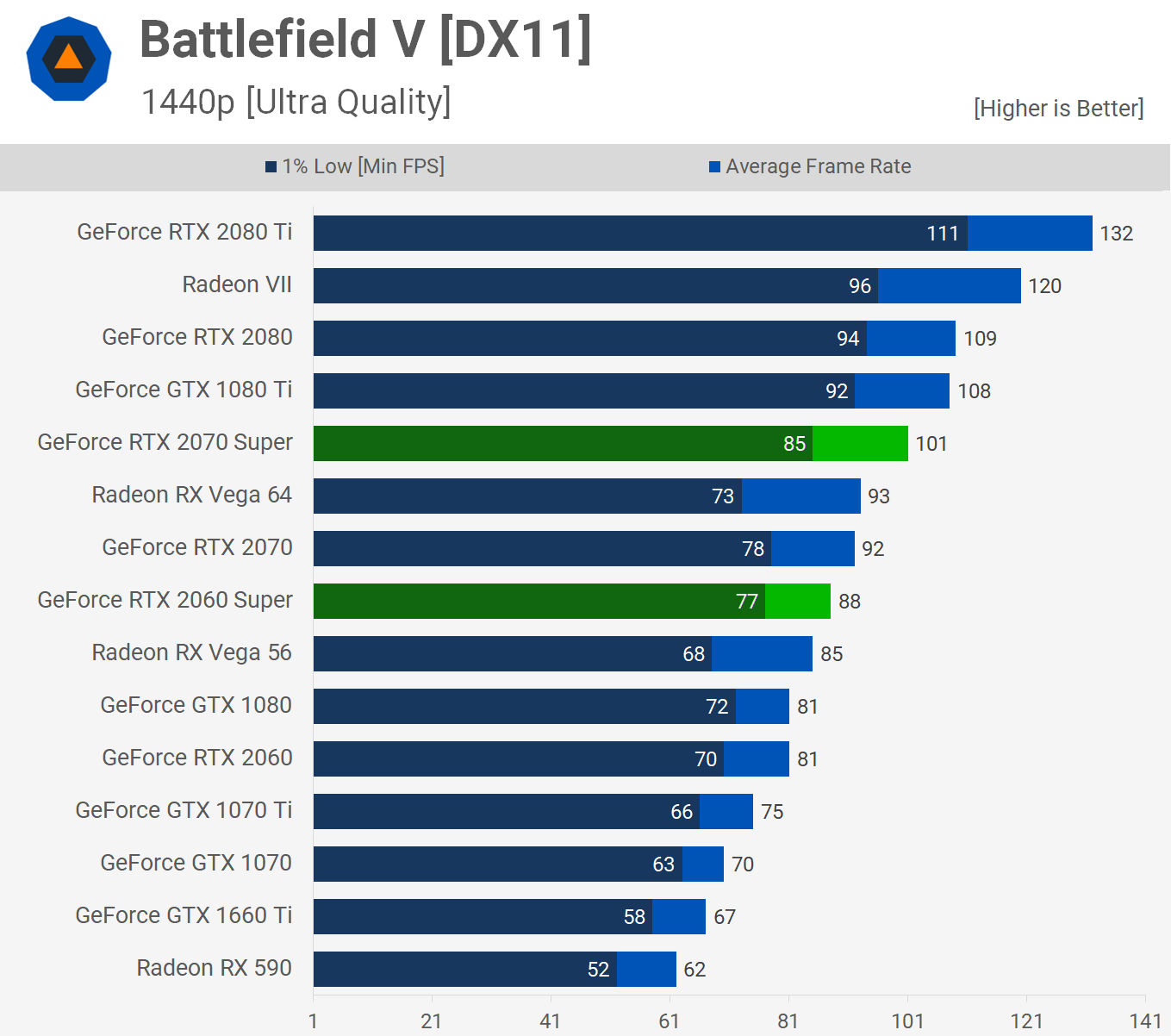
This time when testing with Tom Clancy's Rainbow Six Siege the RTX 2070 Super is closer to the 2080 than it is the 2070 and it also comfortably beat the older GTX 1080 Ti, so a very solid result here. We should also note that it comfortably beat AMD's Radeon VII, too.
The 2060 Super was 16% slower than the 2070 Super with an average of 111 fps and this placed it a little behind the standard 2070. Another instance of a good but not particularly impressive result given the increase in price.

Moving on we have Metro Exodus, here the 2070 Super was nipping at the heels of the Radeon VII, falling short by just a few frames per second. This also meant it was much closer to the RTX 2080 than it was the 2070. Then we see the 2060 Super outpacing the standard 2060 by a 10% margin to deliver 2070-like performance.

Testing with Resident Evil 2 has the RTX 2070 Super right on the Radeon VII's tail again and sitting right between the 2070 and 2080. The 2060 Super is a smidgen slower than the 2070, but faster than Vega 64, so another 10% performance boost over the standard 2060.
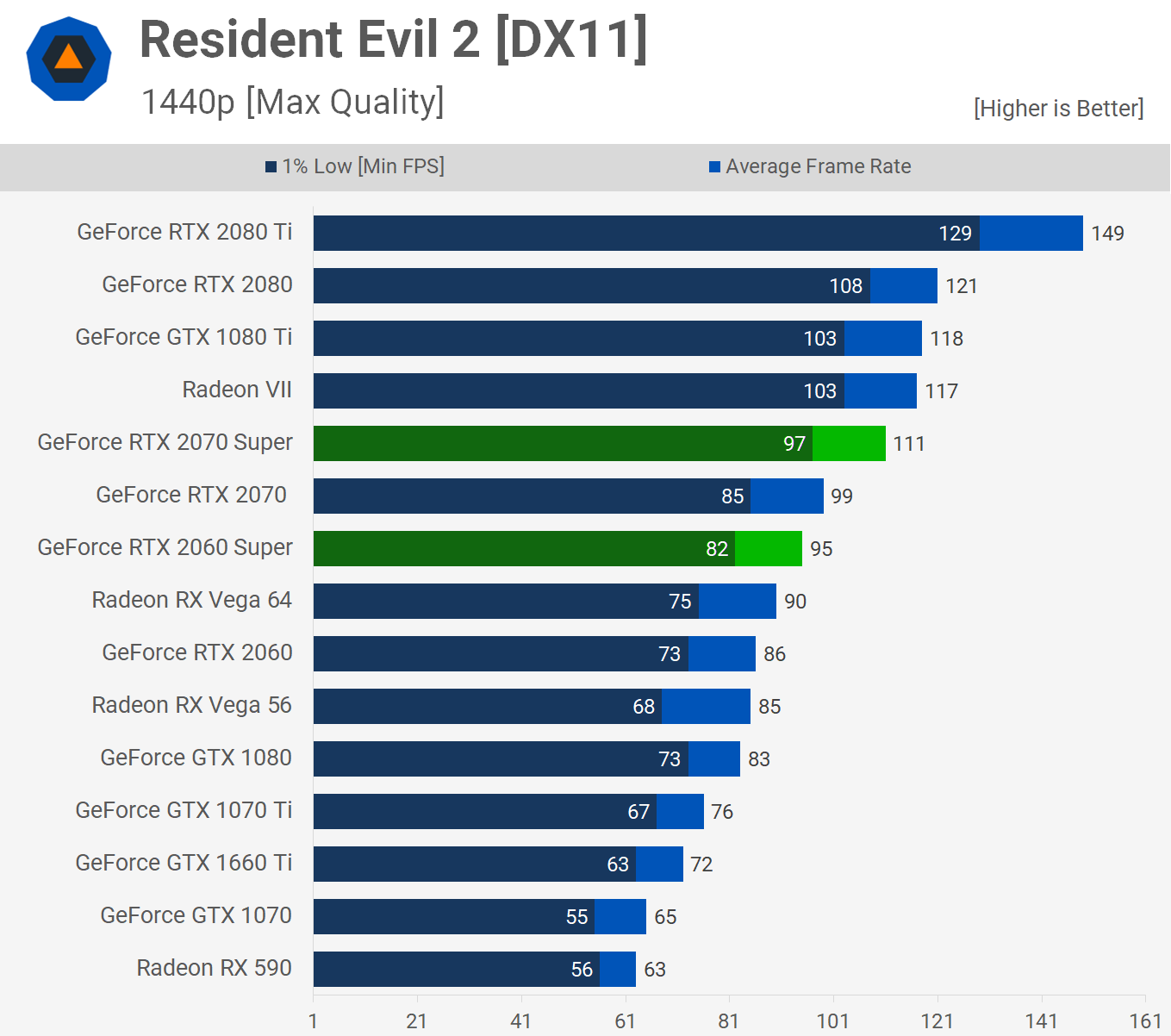
The 2060 Super is a little more impressive in Shadow of the Tomb Raider, beating the 2060 by a 13% margin and this made it quite a bit faster than Vega 64. Meanwhile the 2070 Super matched the GTX 1080 Ti and was just a few frames slower than the RTX 2080, so a very solid result there.

Fortnite isn't a great title for AMD. The RTX 2060 Super is just 5 fps down on the much more expensive Radeon VII. The 2070 Super was quite a bit slower than the RTX 2080, but it had no trouble brushing the Radeon VII aside, beating it by an 11% margin.
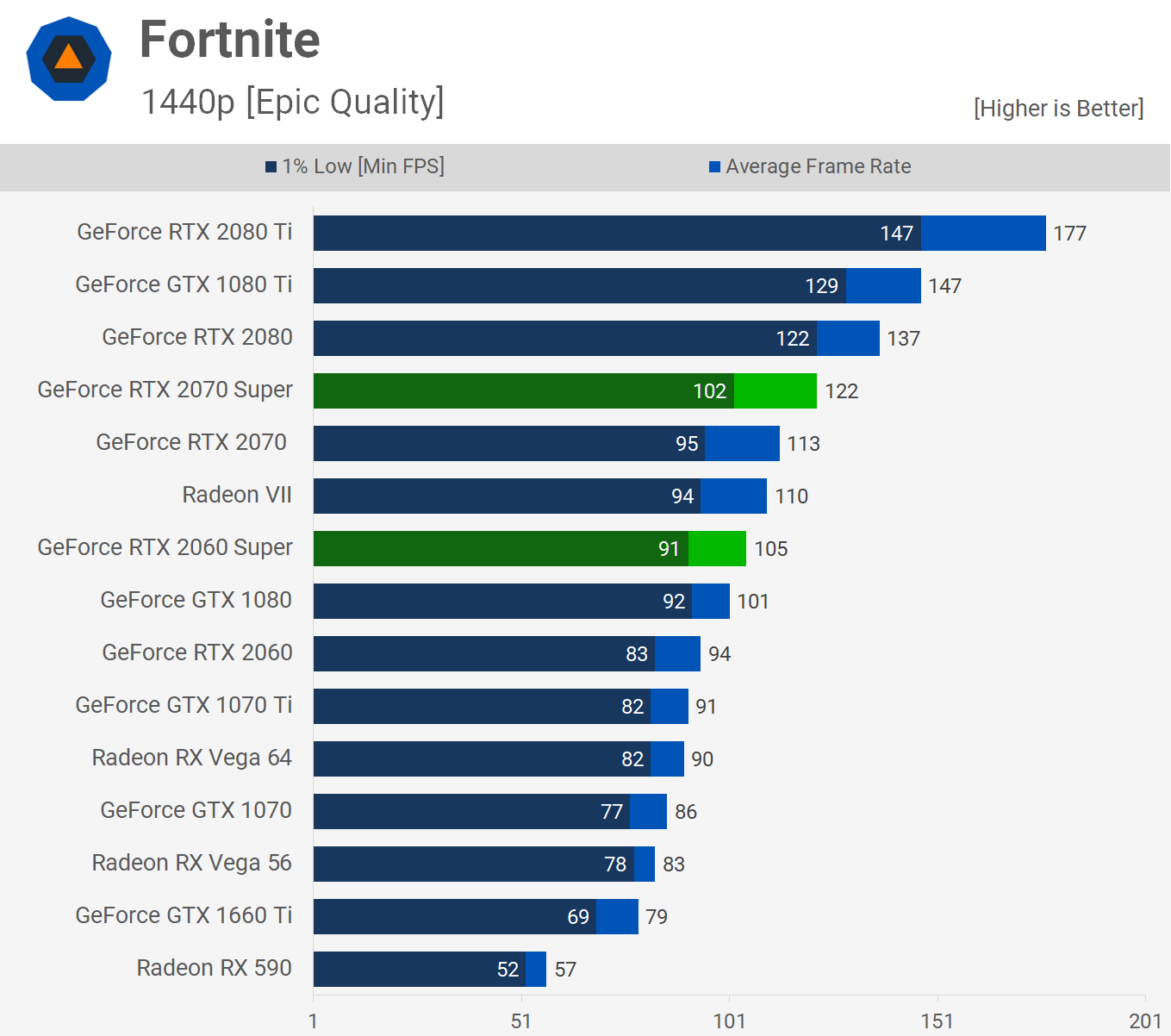
The Division 2 results look pretty typical given what we've seen so far. The 2060 Super is 10% faster than the standard model and the 2070 Super is 14% faster than the standard model. This made the 2070 Super faster than Vega 64 while the 2070 Super was faster than the Radeon VII.
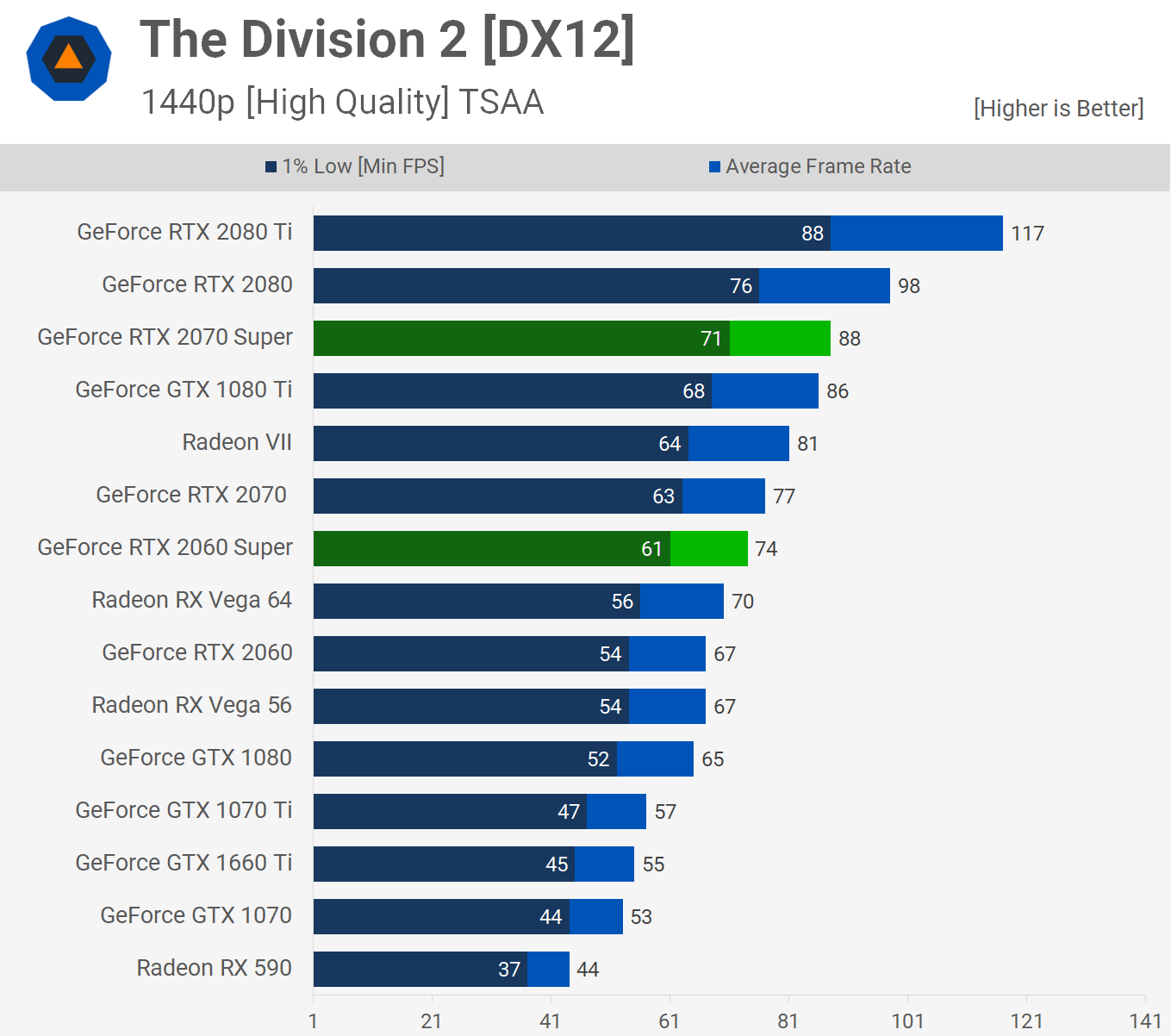
The Radeon GPUs fair much better in DiRT Rally 2 and here the 2060 Super is only able to match Vega 64 and was just 5% faster than Vega 56 which is now selling for around $300. The 2070 Super was just 7% slower than the Radeon VII, so it fares better in this comparison.

Here we have another racing simulator in Forza Horizon 4 and coincidentally this is another great title for AMD. The Radeon VII streaks ahead of the 2070 Super, making Nvidia's new $500 offering 17% slower. The 2060 Super is also done in by Vega 56, losing by a 10% margin.

Moving on to some Far Cry New Dawn testing and here we see the 2060 Super right behind the 2070 while the 2070 Super is right behind the 2080. This means the 2060 Super was able to match Vega 64 but the 2070 Super was 8% slower than the Radeon VII.

In World War Z the RTX 2060 Super couldn't keep pace with Vega 56, while the Radeon VII was significantly faster than the 2070 Super. Still relative to Nvidia's own product stack these new Super versions performed quite well.
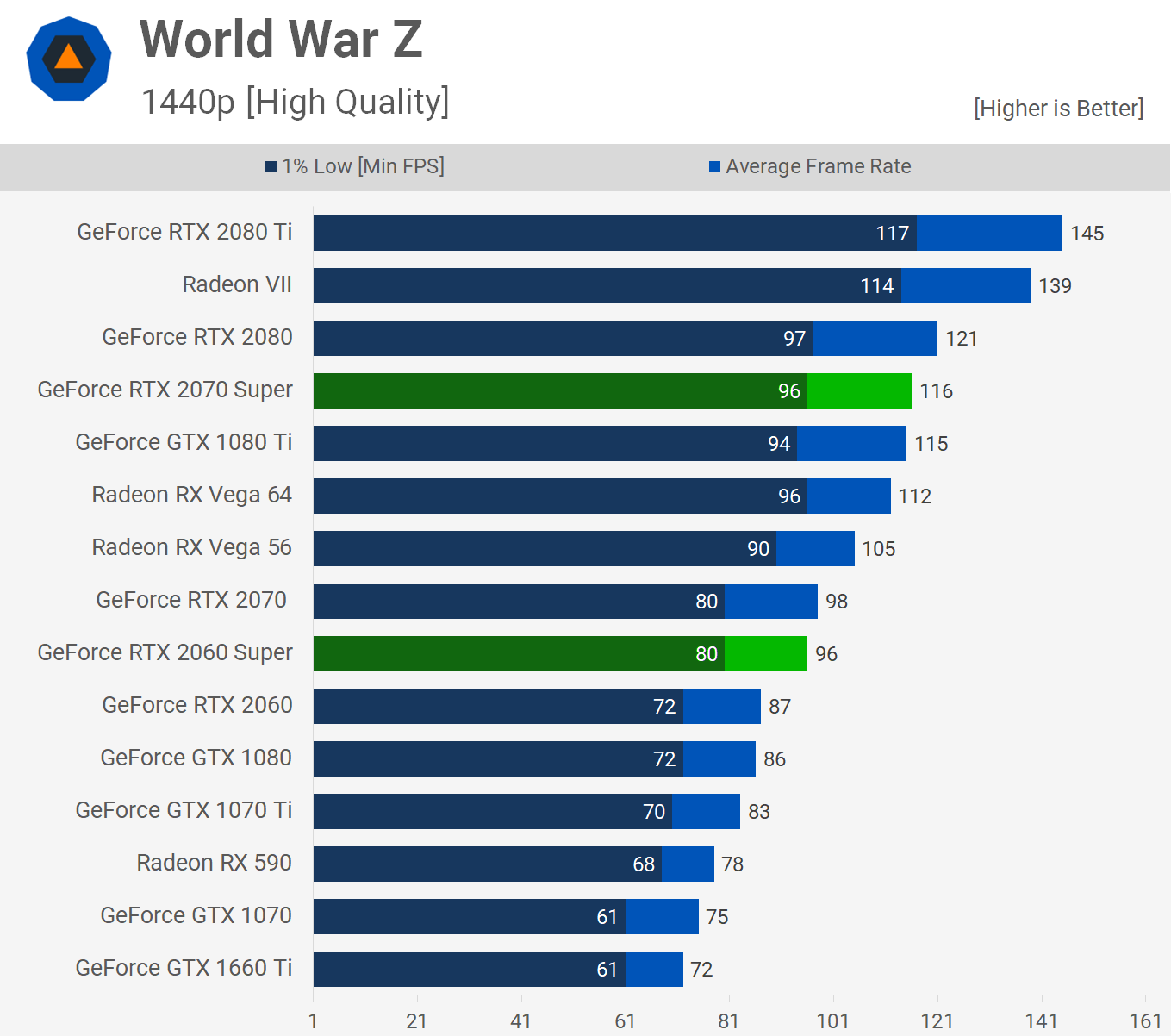
Finally we have Assassin's Creed: Odyssey... here the 2060 Super was 11% faster than the standard 2060 which is typical based on what we've seen so far. Meanwhile the 2070 Super was 10% faster than the standard 2070 and this put it right on the tail of the 2080 and 1080 Ti. So that's going to do it for the gaming benchmarks, let's move on to check out power consumption.

Power Consumption
Looking at GPU consumption first we see that the RTX 2060 Super is very efficient, consuming only 5% more power than the standard 2060 and just 2% or 4 watts more than the Radeon RX 590.
The RTX 2070 Super jumped up to 198 watts and that made it 11% more power hungry than the 2060 Super. Still it was considerably more fuel efficient than the Radeon competition, consuming 20% less power than the Radeon VII.
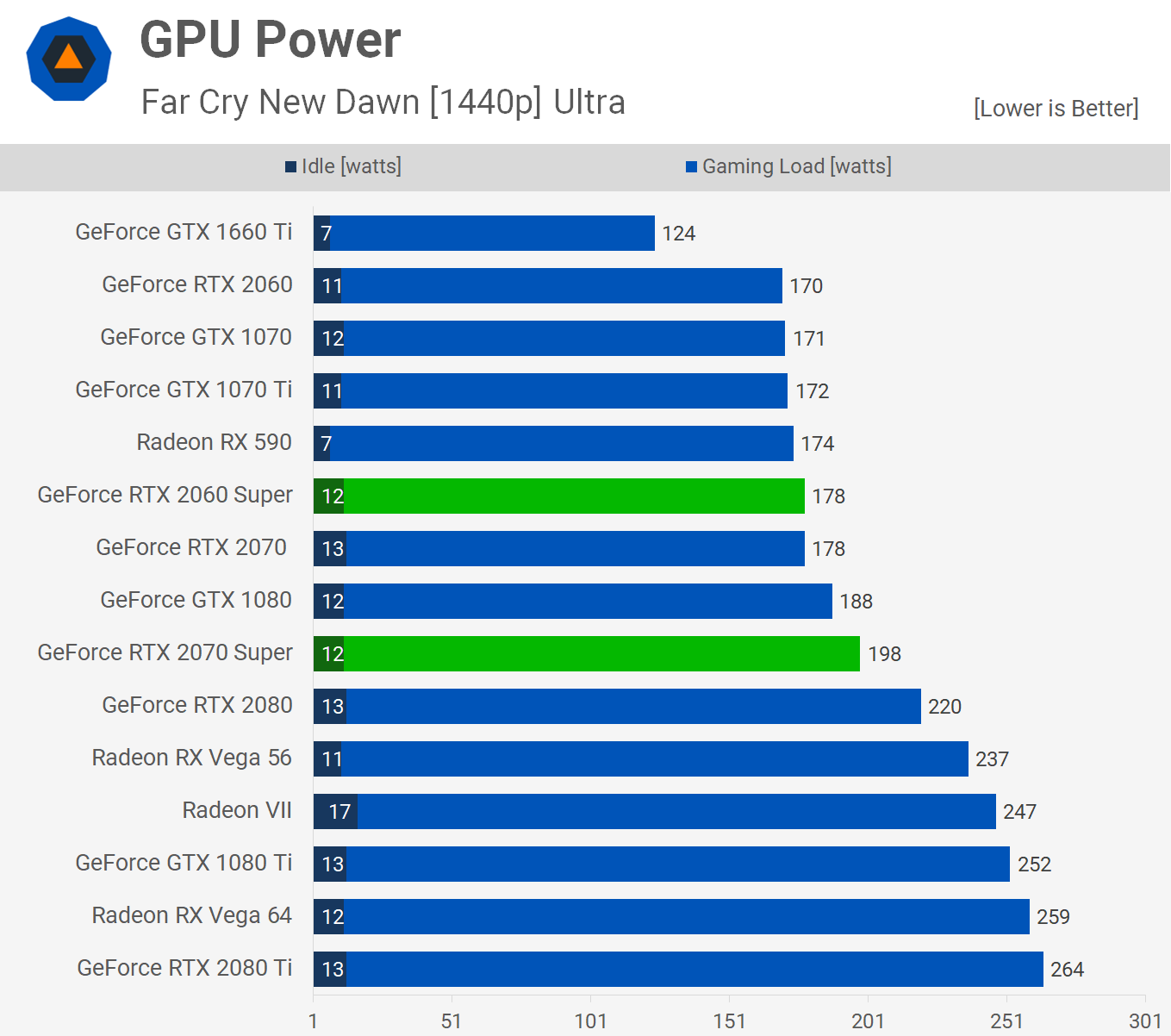
However once we factor in the entire system draw those margins are reduced substantially. Now the 2070 Super consumes just 10% less power than the Radeon VII. There are some interesting changes here when measuring power draw from the wall. Vega 64 jumps well ahead of the RTX 2080 Ti, in the GPU test it consumed slightly less power.
The reason for this change is that we're now including the power draw of the graphics card as well as other components such as the CPU, which has to work harder when paired with certain GPUs, typically the more powerful models. Anyway, the Super variants slot in exactly where you'd expect them to in terms of power usage.
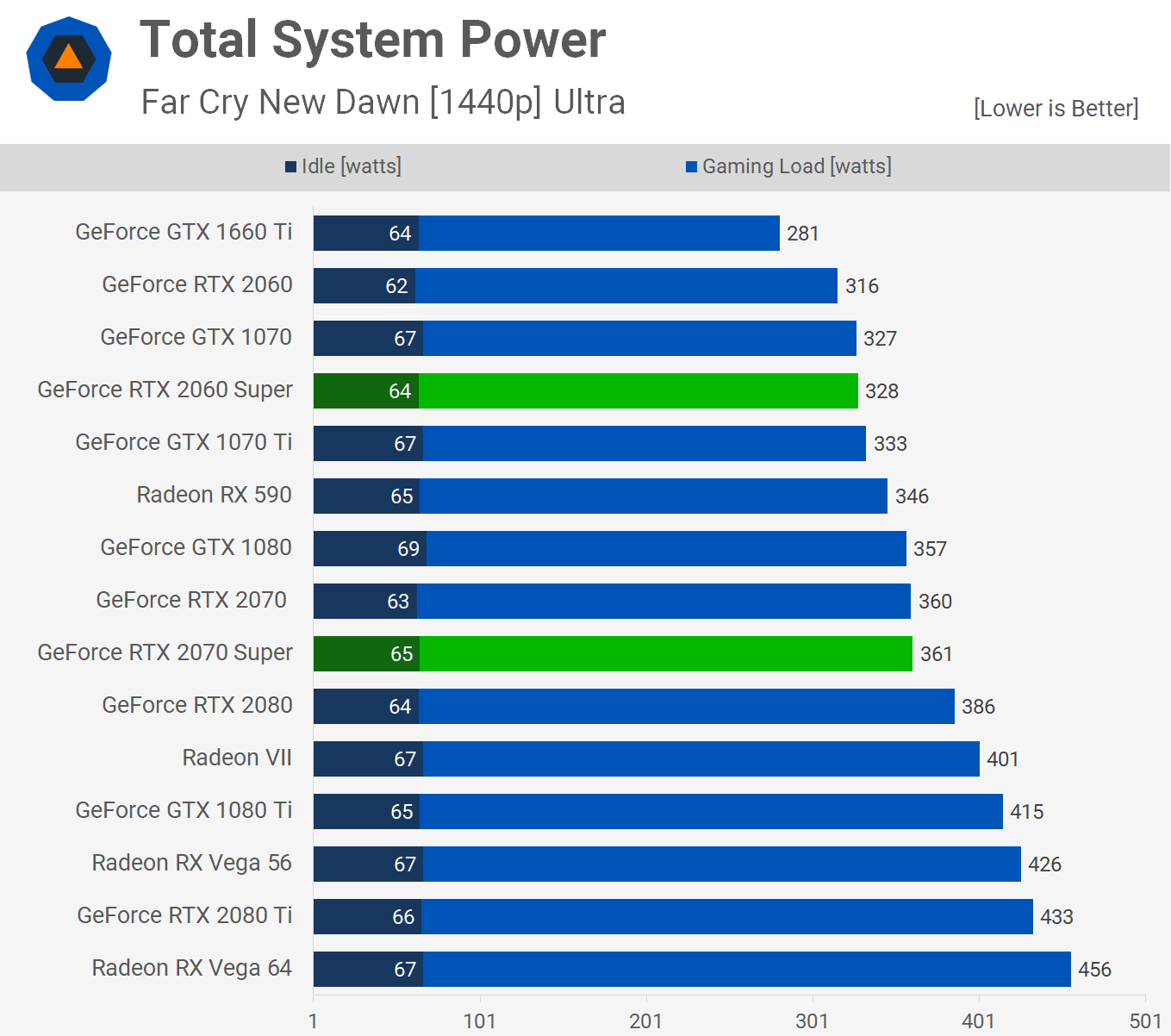
Overclocking
Moving on into operating frequencies, temperatures, fan speeds and a little overclocking. Out of the box the RTX 2060 Super Founders Edition ran at 70C with a fan speed of just 1650 RPM, so it was virtually silent. The GPU maintained an average operating frequency of 1815 MHz after an hour-long loop of the F1 2018 benchmark.
Overclocked our sample was able to sustain 2010 MHz after the hour long test and this saw the operating temperature increase to 75C with a fan speed of 1900 RPM, so a pretty typical 11% overclock for a Turing based GPU.
Moving on to the 2070 Super and we see out of the box the Founders Edition model peaked at just 68 degrees with a fan speed of 1600 RPM, and this allowed it to maintain an operating frequency of 1890 MHz.
Overclocked our sample maintained an operating frequency of 1980 MHz. During the first few minutes of the test it was running at over 2 GHz but after about 5 minutes began throttling down and by the end of the hour sustained 1980 MHz which is a mere 5% overclock. The card was only running at 71C with a fan speed of 1700 RPM, so it was incredibly quiet.
Performance Summary
With all that performance data behind us, let's make full sense of it. For that we have a few performance breakdown charts, head to head comparisons, and then we'll check out our cost per frame graph.
RTX 2060 Super vs. RTX 2070
As you can now guess, the RTX 2060 Super is only slightly slower than the original GeForce RTX 2070. For the most part ~4% slower with the only game where performance was a match being Assassin's Creed Odyssey.
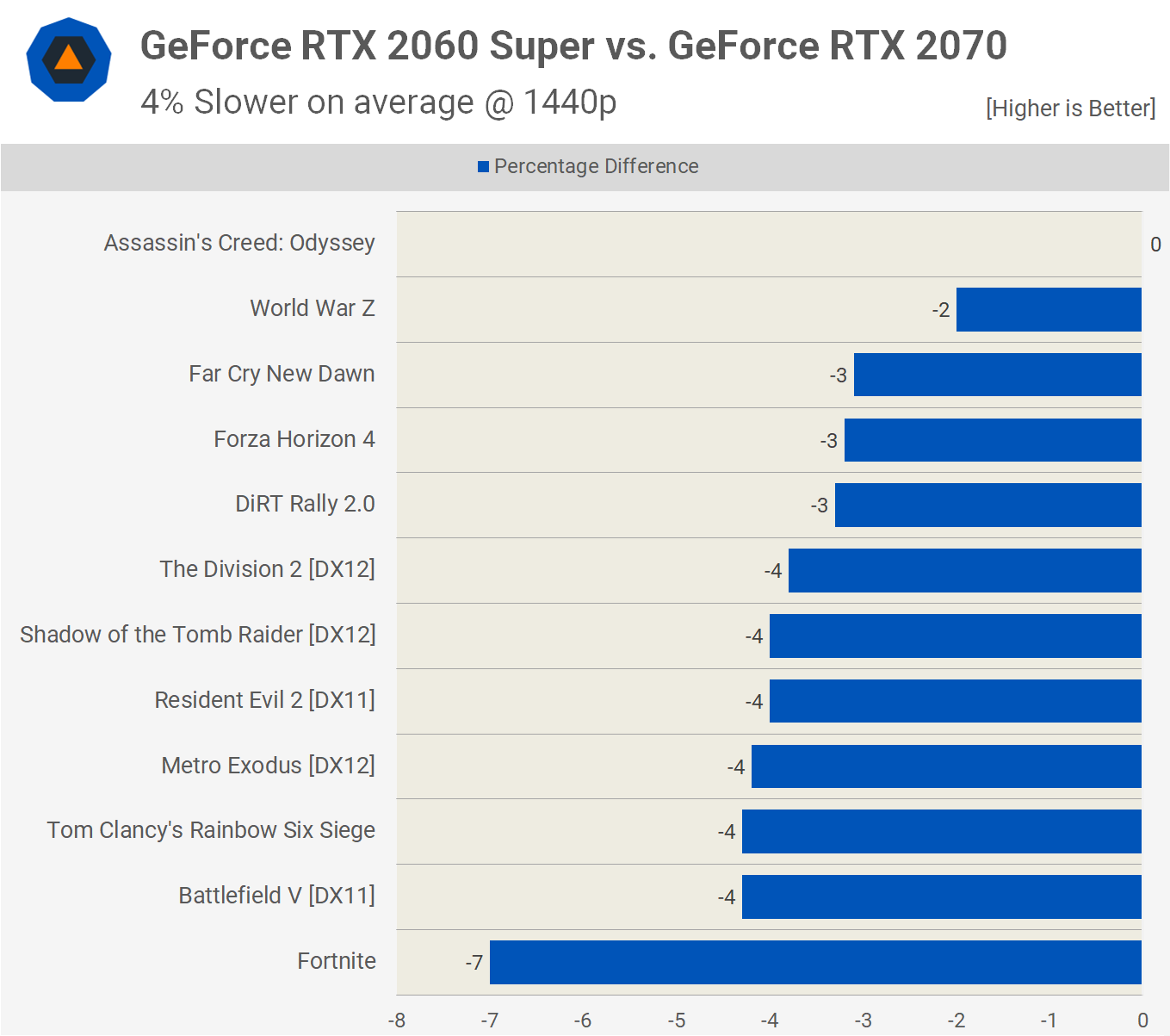
RTX 2060 Super vs. RTX 2060
When compared to the standard 2060 the new super duper version was 9% faster on average, though we are comparing it to MSI's Gaming Z version. Nvidia suggests the Super model should be 15% faster to a regular clocked version, though either way it's not an overly impressive boost given you also have to pay 14% more for it.

RTX 2060 Super vs. Radeon Vega 56
A less favorable scenario for the new 2060 Super is seen when compared to AMD's Vega 56 which can be had for less than $300 now. Surely that GPU is on the way out, but at least in the short term it delivers good value.
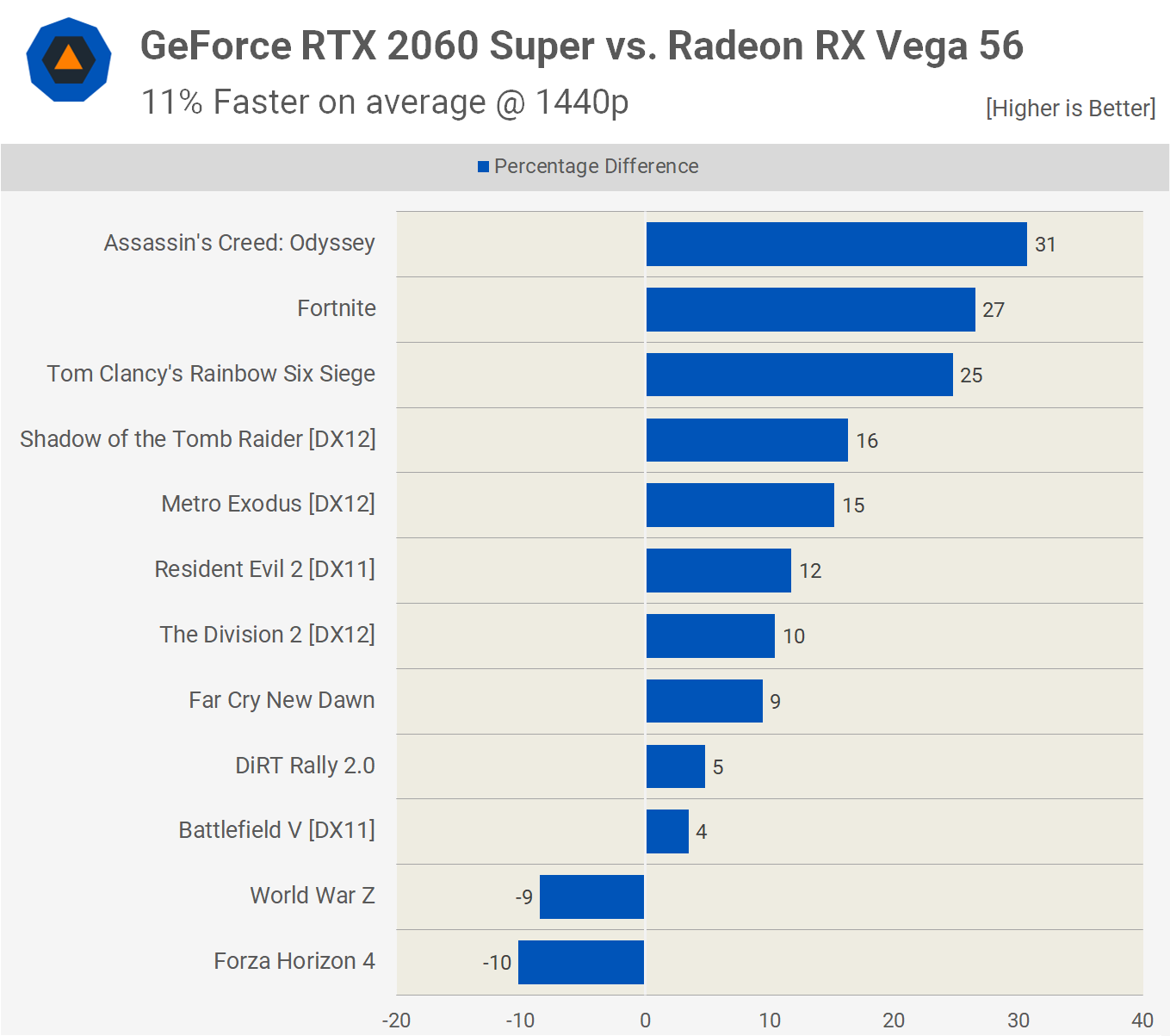
RTX 2070 Super vs. RTX 2080
Moving on to the 2070 Super, on average it was a mere 7% slower than the much more expensive RTX 2080, effectively eliminating that part as the 2070 Super is almost 30% cheaper. At least relative to existing RTX parts the 2070 Super does look like a good deal.
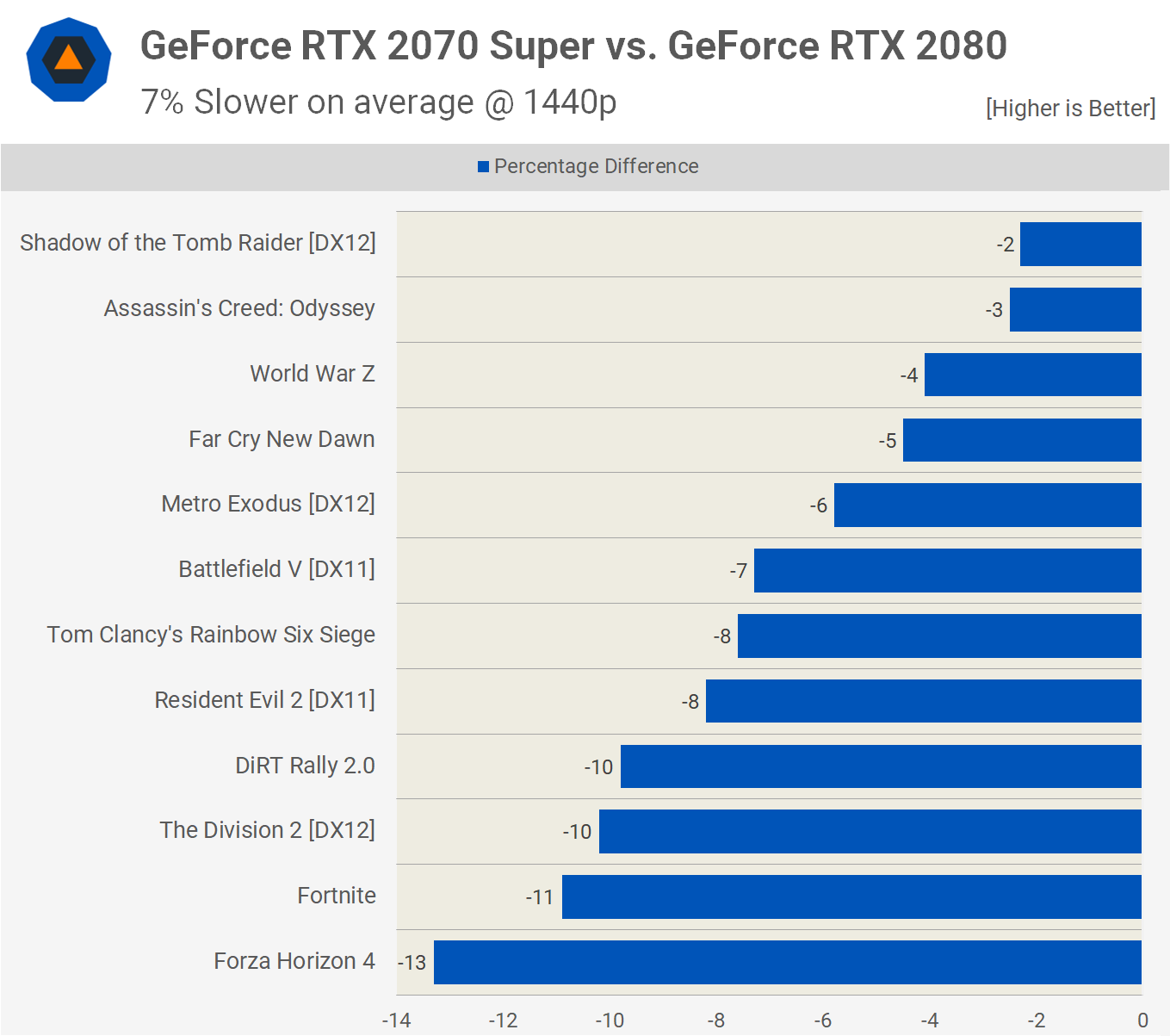
RTX 2070 Super vs. RTX 2070
On average you're getting 12% more performance for the same price, it's not an amazing deal but it revives the RTX 2070 as a true contender.

RTX 2070 Super vs. Radeon VII
The 2070 Super is just 4% slower on average than the 7nm Radeon. Considering it will set you back far less (26% savings) the 2070 Super effectively kills the Radeon VII as it was never more than 17% slower. Without a price cut the Radeon VII can be declared dead at this point.
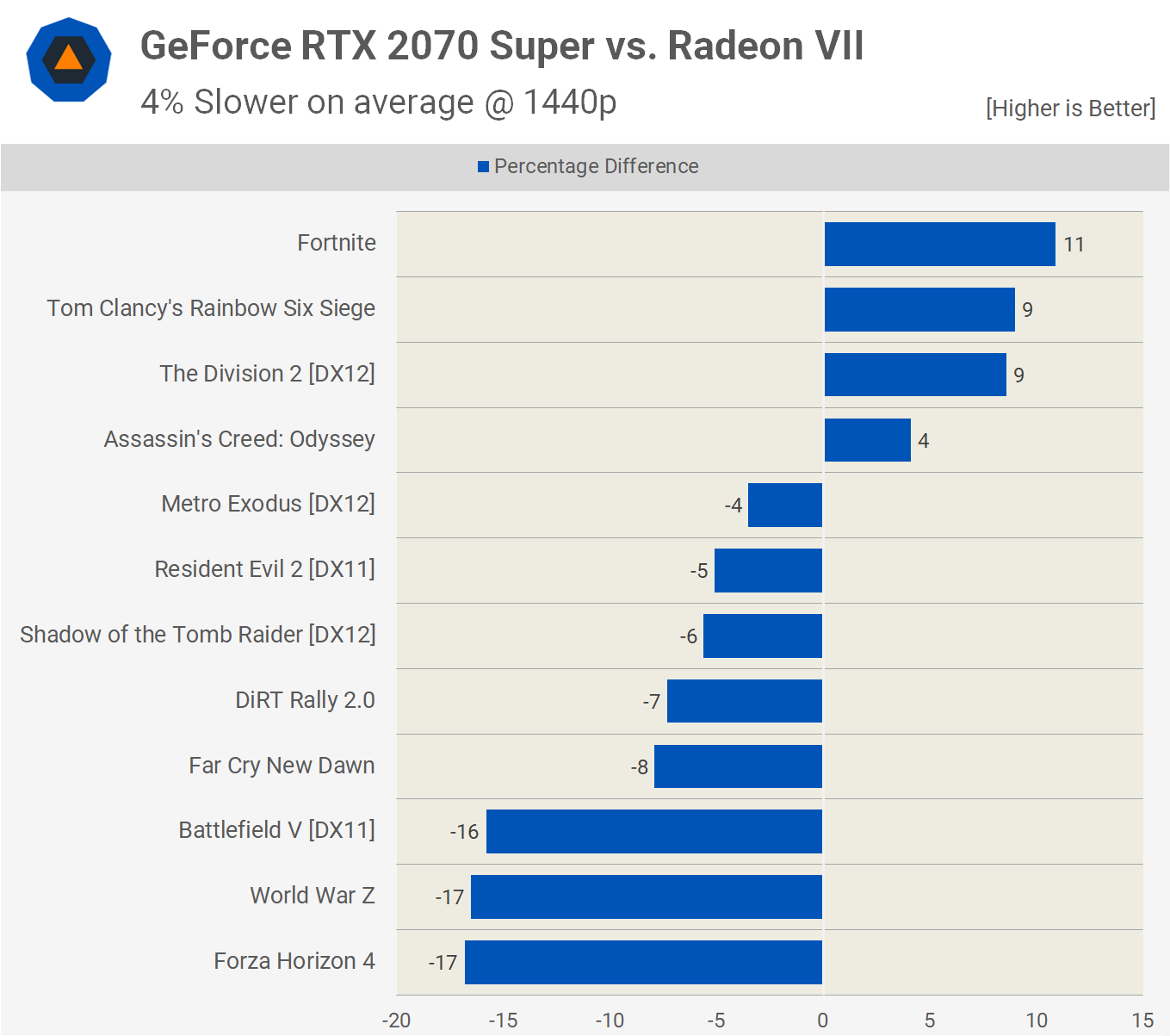
Cost per Frame and Closing Remarks
Running a true cost per frame analysis can be a little tricky at launch since cards can be more expensive initially until things settle, and full discounts on older models are not realized until later as well. For that reason we're running an MSRP comparison before we look at the current asking prices. Don't focus on this data too much as it can be misleading, but we wanted to compare MSRPs first as it shows where we came from with the Pascal generation.
Here we see the 2060 Super costs $4.59 per frame and that makes the GTX 1070 24% more costly, which sounds good for Turing, but remember the GTX 1070 is a 3 year old product. While that is progress, it's not a lot of progress. We should note that the 2060 Super is 30% faster than the GTX 1070, but it's also 5% more expensive.

The 2070 Super on the other hand comes out at a cost of $4.90 per frame, so it's 16% faster than the 2060 Super but only costs 7% more per frame, making it the better value option. This also means the GTX 1080 Ti cost 33% more per frame, so not a bad result for the 2070 Super comparing it to a now 2 year old product.
Now let's compare the MSRP of the 2060 Super and 2070 Super to the current market prices of competing products. For this we've removed the end of production Pascal parts as new models are overpriced.
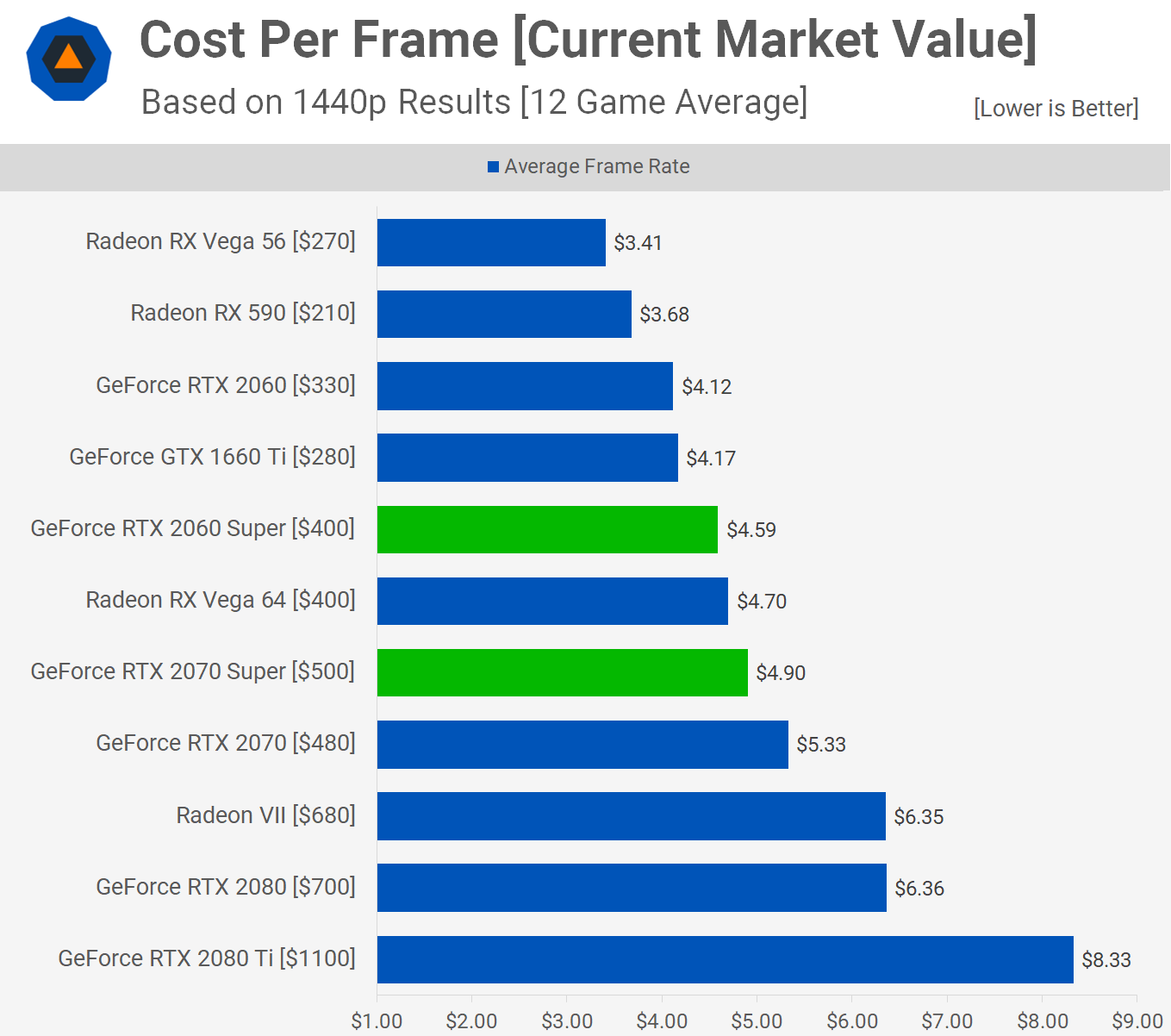
Here we see that the 2060 Super remains a worse value than the 2060 since you can buy some models for a slight discount at $330. Worse still, you can get Vega 56 for just $270 right now and that makes the 2060 Super 35% more costly per frame. Having said that, keep in mind those Vega 56 deals aren't available in all regions.
Thankfully the 2070 Super is better value than the 2070. An 8% discount per frame is not exactly a cause for celebration but it does manage to one-punch knock out the Radeon VII and RTX 2080 graphics cards, so there's that.
Wrap Up
In case it isn't obvious, this is Nvidia's attempt to steal AMD's thunder as they launch Navi next week. In our opinion they could have given us a lot more, but perhaps they don't need to.
We are obliged to ignore AMD's Navi from the equation as we're under NDA with cards sitting on the test bench right now... so ignoring Navi, it's fair to say this ~12-month refresh from Nvidia is somewhat underwhelming, but maybe we won't really know how pricing plays out until GPUs from both camps are fighting it out in the street in the weeks to come.
The RTX 2070 Super is good, it kills off the Radeon VII at its current price and does the same to the RTX 2080. So you're almost getting $700 performance for $500, almost. There's also no better deal to be had at this price point and that's why we need AMD to step it up a notch, or ten.
We're definitely more excited about the RTX 2070 Super's prospects than the 2060 Super. Price to performance the 2060 Super is technically better value, but you expect that with lower end parts. The new 2060 Super is more costly than the original for a small boost in performance, though you do get that extra 2GB of VRAM.
The Founders Edition cards we tested ran cool and very quiet, the build quality is excellent and they look nice. But perhaps most exciting of all, this time around you don't have to pay a premium for the FE models, you can get them at the base MSRP making them worthy of our recommendation.
Shopping Shortcuts:
- GeForce RTX 2070 Super on Amazon, Google Express
- GeForce RTX 2060 Super on Amazon, Google Express
- GeForce RTX 2080 Ti on Amazon, Google Express
- AMD Radeon RX 5700 XT on Amazon, Google Express
- AMD Radeon RX 5700 on Amazon, Google Express
- GeForce GTX 1660 Ti on Amazon, Google Express
- AMD Ryzen 9 3900X on Amazon, Google Express
- AMD Ryzen 5 3600 on Amazon, Google Express
- AMD Ryzen 5 2600X on Amazon, Google Express





